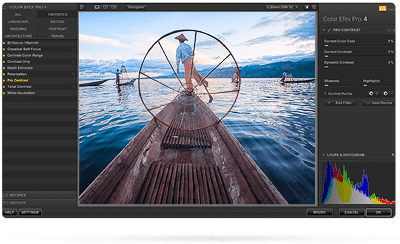
INTERVIEW
WITH JOSH HAFTEL:
THE MAKING OF
NIK COLLECTION


In 2001, just six years after the seeds of Nik Collection first emerged, Josh Haftel joined a plucky young company looking to shape the future of digital photo editing.
As we celebrate 30 years of Nik Collection, check out Haftel’s fascinating story.
HOW IT STARTED
I joined in 2001, fresh out of college (where I studied photography) and stayed through Google's acquisition. I continued working on the products at Google through to the end of 2013. My first role at Nik Software was Imaging Specialist, where I provided customer and technical support, basic software QA, and presentations at training events and trade shows. In 2004, I transitioned into product management and oversaw the creation of Analog Efex Pro, Color Efex Pro 2 and 4, Dfine, HDR Efex Pro 1 and 2, Sharpener Pro 2 and 3, Silver Efex Pro, Snapseed, and Capture NX 1 and 2.
THE EARLY DAYS OF DIGITAL IMAGING
When I first joined, digital photography was still in its commercial infancy. Most digital photographs were scans of film, and most photographers we tried to sell our product to were not interested in post-production. Our most popular piece of software was Sharpener Pro, as it focused on regaining lost sharpness through the reproduction life cycle of scanning and printing.
Convincing people to spend money on post-production software was quite difficult at the time, but we found our niche with amateurs. They especially appreciated the photography-specific language that the products used, which made the product much easier to use than Photoshop. (At the time, neither Adobe Camera Raw nor Lightroom existed, and Photoshop's most used tool for photographers was the Curves tool).
Over time, as digital photography advanced and as people warmed to the idea of post-processing, it became a lot easier to explain what our products were. The plugin landscape for digital photography blossomed, and photographers had an amazing range of different tools that they could add to their photographic toolkit.
“ One of our overarching goals was to make digital photography and post-processing more human. ”
We recognized a significant problem that prevented people from achieving what they artistically envisioned was the difficulty of making selections. At the time, most photographers were using the Magic Wand tool in Photoshop to try to make a selection, and the result was very artificial-looking edits, so we envisioned a way to make selections more naturally, and U Point™ technology was born.
From there, mobile became the next big opportunity space, where we were able to build Snapseed to help anyone feel like a Photoshop pro right from their phone.
Once we were acquired by Google, we had the amazing opportunity to drop the price of the Nik Collection considerably and make Snapseed free, helping to spur huge growth of the products, and getting them in the hands of more and more photographers around the world.
A BLACK & WHITE INNOVATION
Silver Efex Pro, while not necessarily a technological innovation (though there were definitely some really innovative technologies), was a huge sea change for high-quality photographic-centered post-processing tools. So many plug-ins at the time were cheesy and gimmicky, and Silver Efex Pro was our love letter to one of the most unique forms of photographic expression, black and white photography.
SHAPED BY USER FEEDBACK
We were lucky to have an incredibly passionate and engaged community of users and professionals. We would regularly visit photographers' studios, post-production houses, and prepress service providers to see how the products were used and to understand their needs. We also had a strong relationship with a number of photography schools, which is even how I got my job in the first place (I met the CEO while in my senior year at RIT in Rochester, New York, the home of Kodak).
The leadership team at Nik also felt customer service was one of our top priorities; we had a policy of having a human answering the phone every time, providing 24-hour reply policies for emails (during work the week), and eventually live training sessions 3 times a day, 5 days a week so that we could always have a constant feedback loop with our customers. The teams' priorities were based on customer feedback and needs, with nearly all of our best features and product ideas coming directly from our customers.
A SOURCE OF PRIDE
To this day, one of my proudest moments comes from the work I did on Snapseed. When we first met with the design agency that helped us come up with the name and design language for Snapseed, they asked us each, "how will you know when (the then unnamed app) is a success?" The answer that came immediately to mind was "When someone I don't know recommends this app to me."
That happened a year after I left Google, while traveling and photographing the world; someone on a beach saw my camera around my neck and came up to me and said, "Hey, it looks like you like photography — have you ever tried Snapseed?" Even now, reliving that day gives me goosebumps.
THE BIGGEST CHALLENGES
One of the hardest problems to deal with as a plugin maker was access to the computer's resources. In the early days, Photoshop (and later, Aperture and Lightroom) restricted access to memory and processor resources, which limited the type of processing we could do. (For example, early on, we could only access a small amount of RAM, one of the available processors or cores, and had no access to the GPU.)
We had to work around limitations to these important computing resources without sacrificing quality, speed of interaction, and predictability of output. We worked very closely with Adobe, Apple, and Intel to identify opportunities to optimize both the platform as well as our software to work around and expand those limitations.
In the early days, staying profitable was a challenge. Photography software was not an easy space to work in, and the company never took on VC funding; everything was bootstrapped through sales, at least until we took on a minority investment from Nikon.
As the company grew and our products became more diversified, the pressure around profitability lessened (but never fully went away), and made way for other challenges like the ever-evolving landscape. Those new challenges included the commoditization of capabilities (for example, Lightroom integrated a sharpening solution that essentially eliminated most of our customers' need for Sharpener Pro) and the introduction of mobile photography, which created a new set of users with very different needs.
TAKING IN THE COMPETITION
We always perceived our primary competitor to be Adobe, and it was only a matter of time before Adobe would introduce functionality that would invalidate the need for some of our plugins. We watched the evolution of Lightroom and the photography-specific tools that Adobe was creating very closely, with Snapseed and its downmarket focus being an important hedge.
Today, the biggest challenges faced by similar software today are commoditization and good enough edits. When we can have a tool that can replicate any look with very little effort (e.g. GAN-based style transfer), there's less need to learn a nuanced tool with lots of power.
EVOKING TRUE USER LOVE
My advice for new developers working on similar projects would be to identify a niche, and become the undisputed winner of that niche. Don't worry about chasing after the top spot; rather, ensure that you're becoming indispensable for a group of users, and then figure out what made your tools so indispensable and try to duplicate that pattern.
There's a ton of "OK" tools out there, and the world needs more tools that evoke true user love.













